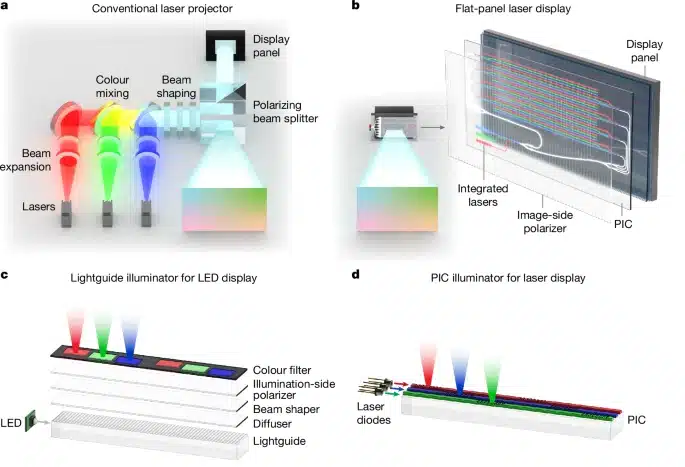
A large-scale photonic circuit enables precise optical control for flat-panel laser displays, supporting full-HD modulation and colour-sequential imaging with applications in AR and beyond.
A flat-panel laser display using large-scale visible photonic integrated circuits (PICs) has been demonstrated by researchers. The display is 2 mm thick and combines a PIC-based laser illuminator with a liquid-crystal-on-silicon (LCoS) panel. The prototype delivers over 200% of the sRGB colour gamut and reduces system volume by more than 80% compared to conventional laser projector-based LCoS displays.
Conventional laser displays rely on bulky optical setups with free-space beam shaping and colour mixing modules. These increase system complexity and limit miniaturisation, especially for augmented reality (AR) and wearable displays. The PIC-based approach integrates all optical routing and beam-shaping functions on a single chip using passive waveguide components, eliminating the need for external optics.
The system routes RGB laser light through cascaded Y-splitters and wavelength multiplexers. Emission is handled by custom-designed grating outcouplers patterned in an aluminium oxide layer above silicon nitride waveguides. A three-layer stack allows fine control over polarisation, angular spread and colour uniformity. Measured waveguide losses are 0.1 dB/cm (red), 0.3 dB/cm (green), and 1.1 dB/cm (blue).
A full-HD LCoS panel with a 4.5 µm pixel pitch is used for image modulation. Integrated with a polariser, the system supports reflective imaging and achieves a 50° diagonal field of view when coupled with a commercial AR waveguide combiner.
Remaining challenges include speckle artefacts, alignment sensitivity, and global-only light modulation. Future development may involve localised PIC-level dimming and improved laser integration for visible wavelengths.
The architecture supports broader use in light-field and holographic displays. Fabrication uses CMOS-compatible processes, making the platform suitable for scaling and mass production. Further optimisation is required for power efficiency and display contrast in AR applications.










